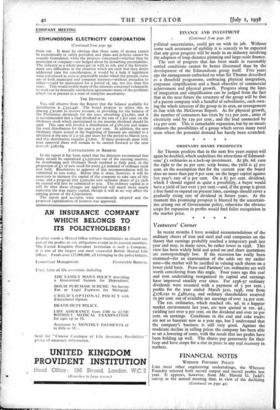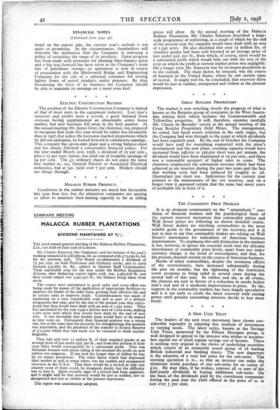FINANCIAL NOTES
WHESSOE FOUNDRY POLICY
LIKE most other engineering undertakings, the Whessoe Foundry enjoyed, both record output and record profits last year. It appears, however, from Mr. Harold G. Judd's survey at the annual meeting that, in.view of the declining
(Continued on page 42)
FINANCIAL NQTES
(Continued from page 4o)
trend on the export side, the current year's outlook is not quite so promising. In the circumstances, shareholders will welcome the intimation that the Company is pursuing a policy of extending the range of its products. Great progress has been made with processes for cleaning blast-furnace gases and a big step forward has been taken in the Company's main line of petroleum storage ; an agreement is now in course of preparation with the Motherwell Bridge and Engineering Company for the sale of a spherical container for storing lighter forms of petrol products under pressure. By thus broadening the basis of its business the Company should be able to maintain its earnings on a more even keel.
ELECTRIC CONSTRUCTION RECORDS
The position of the Electric Construction Company is typical of that of most units in the equipment industry. Last year's turnover and profits were a record, a good demand from overseas having supplemented an abnormally active home market, but new business fell away in the final quarter. At the annual meeting Mr. James Gray, the chairman, was prepared to recognise that trade this year would be rather less favourable than in 1937, but unless the recession reached proportions which he did not anticipate, he.looked forward to satisfactory earnings. This company has up-to-date plant and a strong balance-sheet and has always followed a conservative financial policy. For the year ended March 31st, 1938, a dividend of roper per cent., plus a 21 per cent. bonus, was paid out of available earnings of 24 per cent. The Li ordinary shares do not enjoy the same free market as, say, General Electric or Associated Electrical ordinaries, but at 34s. yield over 7 per cent. Holders should see things through.
* * * *
MALACCA RUBBER PROSPECTS
Conditions in the rubber industry are much less favourable this year than last, but the plantation companies are sparing no effort to maintain their earning capacity so far as selling prices will allow. At the annual meeting of the Malacca Rubber Plantations Mr. Charles Emerson described a large- scale programme of replanting, as a result of which by the end of the present year the company would have dealt with an area of 1,341 acres. He also disclosed that over i million lbs. of standard grades had been sold forward at an average price of just under 91d. per lb., from which, of course, there would be a substantial profit which would help out with the rest of the crop on which the profit at current market prices was negligible. On a longer view Mr. Emerson was by no means pessimistic as to the outlook. The main factor, he stressed, was the course of business in the United States, where he saw certain signs of revival. It might well be, he concluded, that recovery there would be just as sudden, unexpected and violent as the present depression.
GREAT BOULDER PROPRIETARY
The market is now watching closely the progress of what is known as the Bemales group of companies in the West Austra- lian mining field, which includes the Commonwealth and Yellowdine properties. It will, therefore, examine carefully Mr. Claude de Bernales' survey at the annual meeting of the Great Boulder Proprietary Gold Mines. The management, he stated, had faced severe criticism in the early stages, but the Company had won through to the point at which dividends had been regularly paid. By the end of October the Company would have paid for everything connected with the mine's development and the new plant, crushing capacity would have increased from 148,000 to 336,000 short tons per annum, the dividend would have been maintained at 25 per cent., and ;here was a reasonable prospect of higher rates to come. The chairman emphasised the substantial increase which had been achieved in ore reserves during the past two years and the fact that working costs had been reduced by roughly 2S. 5d. (Australian) per short ton. Indications for the current year pointed to the maintenance of the ore reserves, and on a longer view it appeared certain that the mine had many years of profitable life in front of it.
THE COMMODITY PRICE PROBLEM
It is an eloquent commentary on the " sympathetic " con- dition of financial markets and the psychological basis of the current recovery movement that commodity prices and Wall Street prices are following an almost identical course. Wall Street dealers are watching commodities as the most reliable guide to the genuineness of the recovery, and it is just as true to say that commodity dealers are relying on Wall Street's movements for indications of American business improvement. To emphasise this odd distinction in the markets is not, however, to ignore the essential truth that the ultimate determinant of commodity price levels, apart from any major currency change. is the trend of consumption, and that, for the present, depends mainly on the course of American business.
Stocks of many commodities, despite the strenuous efforts of the restrictionists, have increased substantially during the past six months, but the tightening of the restriction screw promises to bring relief in several cases during the second half of this year. In rubber and tin, at all events, the chances are now in favour of a reduction in stocks before year's end and of a moderate improvement in price. So far, support in the commodity markets has been largely speculative and it is too early to credit the latest recovery with staying power until genuine consuming interests decide to buy more freely.
* * * * A NEW UNIT TRUST The leaders of the unit trust movement have shown con- siderable ingenuity in adapting this medium of investment to varying needs. The latest series, known as the Savings Unit Trust, sponsored by the Fifteen Moorgate group, is well designed to appeal to the investor who wishes to accumu- late capital out of small regular savings out of income. There is nothing very original in the choice of underlying securities which consist of an eminently sound group of 28 leading British industrial and banking shares. The new departure is the adoption of a very low price for the sub-units. The opening quotation is 2s., so that an investor can make the minimum initial purchase of 200 sub-units for an outlay of £20., He may then, if he wishes, reinvest all or part of his. half-yearly dividends in buying additional sub-units. On the basis of the dividends paid by the constituent companies during the past year the yield offered at the price of 2s. is just over 5 per cent.



















































 Previous page
Previous page